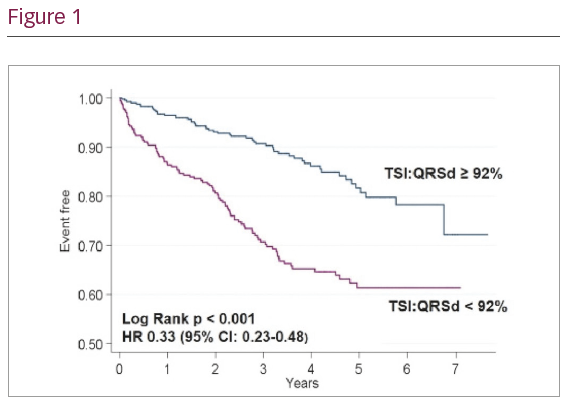Background: Predicting clinical outcomes after cardiac resynchronisation therapy (CRT) remains a challenge. Although QRS duration is crucial as an indication for CRT, it is a poor predictor of clinical outcomes.
Objectives: To determine whether the direction of ventricular activation, measured using the ratio of the temporospatial isochrone to QRS duration (TSIQRSd) on vectorcardiography (VCG) predicts clinical outcomes
after CRT.
Methods: In this retrospective study, TSIQRSd, QRS area, QRS duration (QRSd) and QRS morphology (LBBB), derived from pre-implantation ECGs, were assessed in relation to the primary endpoint of cardiac mortality
after CRT.
Results: In patients (n=720, age 72.8 ± 11.8 years, 71.3% male) undergoing CRT over 7.7 years (median follow-up period of 3.7 [interquartile range 2.3–5.1] years), TSIQRSd <92% predicted cardiac mortality (adjusted hazard
ratio [aHR]: 2.21, 95% CI 1.54–3.17; p<0.001), independent of known confounders. When considered together with QRSd, LBBB and QRS area, TSIQRSd <92% was the only predictor of cardiac mortality (aHR: 2.22, 95% CI 1.55–3.18; c-statistics: 0.59, 0.57, 0.63 and 0.68, respectively). A TSIQRSd < 92% predicted cardiac mortality in the strata of QRSd (< or ≥150 ms) and QRS morphology (LBBB or non-LBBB) (all p<0.0001). Both TSIQRSd <92% and a QRS area <102 ms also predicted total mortality or heart failure hospitalisation, and total mortality or major adverse cardiac events (all p<0.001)
Conclusions: Vectorcardiographic TSIQRSd is superior to QRS area, QRSd and QRS morphology in predicting cardiac mortality after CRT. These findings support the use of pre-implantation VCG in predicting clinical outcomes after CRT.








